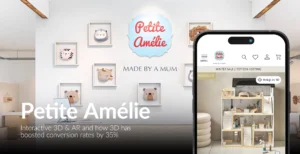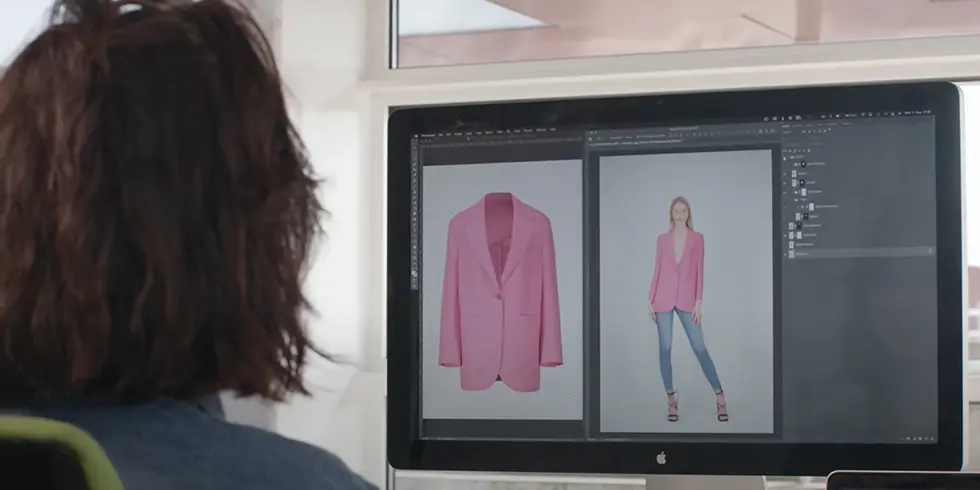StyleShoots and Bright River have teamed up to create the perfect combination of cutting-edge photo machines and innovative editing technology: POS3D for StyleShoots. It’s a cost-efficient end-to-end solution to produce premium e-commerce model photography at scale, ready to upload to your webshop and start selling in less than a day.
Jeroen Gerretsen, Chief Innovation Officer and co-founder of Bright River, joined StyleShoots’ Annabelle Plueckthun for an interactive Q&A session discussing the process and many benefits POS3D for StyleShoots has to offer. This article is a condensed and edited version of that inspiring session.
Could you tell us what POS3D for StyleShoots is and what it does?
Jeroen: The idea is simple. We take an image of a model and combine it with an image of a garment, so it looks like the model is wearing it. But to do that in a way that looks good and converts – to stay in e-commerce terms – requires much experience. So basically, we’ve started developing this service as an extension of our editing portfolio maybe three or four years ago. First, we found that you can create perfect-looking images if you abide by particular rules. Then, using a combination of automated and manual editing, we make sure that the images look as natural as possible.
Combining this editing technology with the StyleShoots machines was logical because we need consistent, high-quality images as input. The StyleShoots Live is perfect for creating basic model shots – and the StyleShoots Vertical captures the garments, both with high, consistent quality. That consistency is the ideal foundation for our POS3D solution.
Can you describe the process a bit more in-depth?
Jeroen: It starts with helping the client set up a basic model library. Doing so requires some refinement. Although this solution offers great variety in poses, you need to know which poses you can and can’t use. Also, you need to have a particular lighting setting and distance to the camera, along with a few other specifics. Getting this right is easy with StyleShoots Live, so if you follow the guidelines for the basic model poses, creating a basic model library is done relatively quickly.
From that point onwards, the actual day-to-day process can start, namely shooting the images on the Vertical. The settings of StyleShoots Live and Vertical are synced, so the output of both machines is the same.
The images are uploaded to Stream – Bright River’s post-production workflow application – directly from the interface of Vertical. First, the image of the garment is paired with the basic model of choice. Next, a part of the editing process is automated using Smart editing technology. The image editors then receive images that are already finished for about 50% or 75%. They refine the images to make sure it looks perfect and natural.
The image is returned to Stream and the client receives a notification that the images are ready to review and approve with a built-in Review tool. You can do this one image at a time, but it is primarily done in large volume batches in practice.
Instead of other solutions that use CGI-generated models, you only work with real models to make them look natural and realistic, correct?
Jeroen: Yes, we have much experience with testing a multitude of different alternatives. But what we found was that working with real models leads to the best, most natural-looking results. We also found that each customer has particular requirements concerning the models. So if you want a plus-size model and have plus-size mannequins, or if you carry children’s clothing and have children-sized mannequins, that’s possible. But even in the nuances there is ample flexibility. Is it a dark-haired model or a blond model? Is she skinny or more curved? With so many varied wants and needs, we can’t create a basic model library before talking to the clients, as the required specifics are best known to the client.
Regarding benefits, could you maybe elaborate on other benefits the solution brings the clients?
Jeroen: It depends on the angle at which you approach this. We service many clients, and some benefits are more apparent to some than to others. The most evident benefit would probably be that it’s cost-saving as you no longer have to hire a model for day-to-to shoots. Now you only employ the model(s) for just one day and create as many basic model shots as you need.
If you look at the total warehouse to web time, POS3D decreases this time significantly. You only need to shoot the garment image to create incredible on-model images. Imagine the time saved, now that you no longer need to dress and style the model.
Another great benefit is that using that same image of the garment, we can create the whole image carousel required to go online, like the on-model shot, detail shots and even an invisible mannequin shot, all from a single image. So after you’ve shot and uploaded one image, 24 hours later you will have all images required to make it shine online.
Speed is also a great benefit. Images are typically ready within 24 hours, but we can even do it in eight hours if needed. Still, on average it’s one day, decreasing the warehouse to web time tremendously.
One of our clients shared that it’s just logistically so much less complex with POS3D. The garment only has to be transported to the studio where Vertical is situated. It is only styled and revitalized once on the mannequin before taking the shot, and then the item can go back. You don’t need to do anything else. On top of that, with the StyleShoots Vertical you only need a stylist, as they can operate the machine single-handed. No need for a photographer.
What exactly do you mean by revitalizing the garment?
Jeroen: Typically, when clothing comes out of the box, there are all kinds of creases and wrinkles that might not look good on camera. Although we can fix a lot in post-production, some ironing or steaming might be required so that it’s good enough to use on a mannequin in StyleShoots Vertical, looking fresh and clean. In other words, you only have to revitalize the garment before shooting once now.
We briefly touched upon the consistency aspect between StyleShoots Vertical and Live. Would you say that’s also one of the most significant benefits of the POS3D for StyleShoots solution?
Jeroen: Indeed. There are a few different aspects when we talk about consistency. When people create the basic model library, sometimes they want to update that library after a few months or even longer. Finding the exact settings that you used three months ago, let alone six months ago, is only possible with StyleShoots Live.
The same goes for shooting the garments. We have clients that produce on multiple locations, scattered across continents even. You can sync the different settings to ensure that they’re the same for all those Verticals, now and in the future. So if you decide to use the machines for a different purpose, you can do that. And then later, you can return to this process and pick up right where you left off.
So the presets on Live and Vertical are helpful for that?
Jeroen: Yes, it’s not hard to make one image look good, but it is hard to make thousands of images look good every time, day in, day out. That’s the real challenge this solution helps you overcome. All images are consistently of high quality, regardless of the volume due to the synced presets.
Making the output look realistic is also heavily based on the correct lighting settings. And, of course, using a real model. Can you explain how you make sure that the final result looks realistic and natural?
Jeroen: Through years of experience, we found many specific things to tweak in order to produce the best results. So we have a lot of expertise in what directly impacts the editing part—for instance, the sizing of the garment. A garment shot on the mannequin has a particular size. That size needs to be transferred to the on-model image.
Using StyleShoots technology, we know the item’s exact size when shot on the mannequin with the Vertical. So we can determine precisely how long a particular coat, sweater or shirt is in centimeters or inches. Of course, we already know how tall the basic model is. We can make sure that the item fits perfectly on the model the same way it would if the model was wearing it. Imagine the impact on your return rate if the jacket sold as a tight fit in reality would be oversized. Matching the fit to the model’s body without distorting the actual shape and size of the garment is one of the most critical aspects of this solution.
Technology plays a big part in the editing process. We run background scripts and Photoshop automation before the image is transferred to a human editor. Then, we use human eyes for the QC and add the final touches to each image. But again, it all starts with very high quality, highly detailed images with very consistent color, created by the thousands on the StyleShoots machines.
You mentioned the human aspect in the actual editing process and the quality checking process to ensure every image the customer receives is 100% perfect and ready to upload to their online shop, right?
Jeroen: Exactly. We run many automated quality checks with smart tech before that, based on advanced computer vision and machine learning. But the final touch-up and quality check are always done by human eyes.
How do you see the collaboration between POS3D and StyleShoots? What do you think makes it so powerful?
Jeroen: We have much experience that came from vigorous testing. First, we found that to create a natural, realistic on-model image, the quality of the input images needs to be high. The more pixels we get to work with, the better. Correcting flaws in the image is easier when the quality is high, and with that high quality, it is also much easier to create a more natural look. Secondly, that quality needs to be consistent, as I mentioned earlier. And StyleShoots delivers every time.
We have worked with StyleShoots for a couple of years now. Together we have built a fully integrated workflow. That integration enables StyleShoots customers to save time by directly uploading from the machines’ interfaces to our post-production workflow application STREAM. For example, in a typical workflow, you would shoot first and upload only at the end of the day. That way, you’ve lost eight hours with the first images you shot that day. You save that time if you upload directly from the StyleShoots interface. That aspect is crucial for a significant number of our clients. Not for all but for those working with tight deadlines, that part is vital.
We have already talked a lot about the ins and outs of the solution. If clients are interested in the solution, how do you get started with POS3D? What would be the first step?
Jeroen: Seeing is believing, so the first step would be to schedule a demo. We do however have a minimum annual volume threshold. If you have 50 items per year, hiring a model and doing the shoot more traditionally is probably a wiser choice. For POS3D for StyleShoots to be really interesting, the suggested volume starts at 25 SKUs a day. It becomes a desirable solution to significantly decrease costs, while increasing your studio output from that volume and up. Or even to reduce the logistical complexity of a standard fashion e-commerce photography workflow, which offers enormous benefits as I stated earlier.
Ready to see for yourself?
All of our demos are free, with no strings attached. And they’re personalized to your business goals to find the solution tailored to your targets. So reach out today to set up a demo with our POS3D for StyleShoots specialists.


